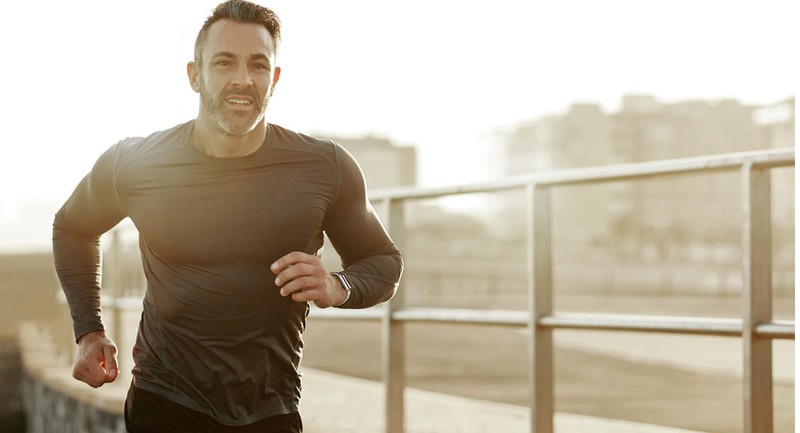How To Be A Better Runner
We caught up with Onetrack’s Anthony Fletcher and 1Rebel’s Jono Selvadurai to find out how to do it right.
So, if you’re not big into running, how do you get started?
Fletch: Get your kit sorted. Comfortable trainers are a must and whether you’re new to exercise or not, the key is to just get out there. Start small and be consistent: try a gentle run for ten minutes and see how that feels. Be realistic about the time available to you in the week. Little and often is the best approach. If you already consider yourself fit but have never run, try some HIIT sessions to get the body used to the mechanics of running.
Jono: Simply tie up the laces and get moving. Think of running as just another play in your playbook. It’s always good to have a little intention. If it has been a while since you last hit the roads, get a little run down once a week, then build it up to two. Before you know it, you’ve created a routine. Just like brushing your teeth. If you like listening to a certain artist, plan to run through one of their albums start to finish and see how far you get. If you like coffee, run to a coffee shop you’ve always wanted to try – that’s not your local.
If you are a runner but don’t feel like you’re making much progress how do you get faster?
Fletch: HIIT classes or Onetrack sessions are great for this. Get on a running track and get your body used to feeling uncomfortable! Also, strength training is key and will help increase speed. Sometimes the challenge is to run by yourself to tackle any mental block. Sometimes the challenge is to run with others to tackle the fear of competition. I advise my runners to run alone, together, with and without music, so they’re not reliant on anything to get them through the distance.
Jono: As with anything, the more you do, the better you get at it. The key is to continually try to work on efficient practice: be clear on quickening the pace and seeing that result. Complementing your running with strength-based exercises will help build that all up. But don’t beat yourself up. We have so many factors come into play – life in general, how well you slept, what you ate, whether work is a little stressful – that mean you’ll have days when your performance dips.
Does what you eat before a run matter?
Fletch: There are lots of myths around fasted cardio. If you are going to be running at an easy pace for anything less than 90 minutes, there is no need for pre-run nutrition. If it's due to be a harder run or interval session, there is a need for fuel. A good, balanced meal should be consumed around two hours before running, with the potential for something a bit sweeter (like banana and peanut butter) half an hour before you run. If you’re really strapped for time, have a banana during the warm-up.
Jono: Heading into a long run, or race day, I like to have a big bowl of pasta the night before. Slow-release carbohydrates are key. We are looking to ensure all that energy can be sustained – you’re not single use! Before a run, nothing beats a good bowl of porridge. Oats are amazing at keeping everything sustained, plus you can go to town on your toppings – just go easy on the maple syrup.
Should you warm up before a run?
Fletch: I’d recommend doing some muscle activations like hip bridges, standing hamstring curls to get the mind-muscle connection initiated. You could also do some short-duration core work and it’s good to raise the heart rate a little pre-run. If it’s going to be a hard workout, your warm-up should lead you up to the work rate that is going to be performed.
Jono: Absolutely. You have to boil the water before making a cup of tea – same deal here. The warm-up is there to mobilise and activate what we need for the run. My top tips are opening up the hips, lunges and bridges, calf raises, opening the upper back up and mobilising the spine.
What about eating post-run?
Fletch: The right nutrition and refuelling is really important after a run – and often overlooked. Avoid quick fixes like gels and energy drinks, which are better mid-race. A balanced meal with plenty of protein is the best option as soon as you’re able to eat properly.
Jono: Refuel the tank with good nutrients. Eat something protein-rich, hydrate, and boost those electrolytes. After a big day, tucker down on something like a big roast. You deserve it.
Can you recommend some good alternatives to a full on marathon?
Fletch: Onetrack1000 is our 1,000-mile run in support of the Blue Marine Foundation. You can enter a 5k, 10k or half marathon to help save our oceans. It’s a pretty big mental challenge, completing laps of the track, but the atmosphere is electric because there’s a real feeling of community as runners of all abilities work to achieve the overall distance goal.
Jono: Some of my favourites in the capital are the Hackney Half, Adidas City runs, the Virgin Sports 10k and the Royal Parks Half. It’s a great idea to book some runs or races out of London, as you’ll get a small vacation as well – and what better way to see a new city than by getting to run around it with the locals cheering you on.
Which is better: running on a treadmill or outside?
Jono: Both are great. Running on a treadmill is convenient, especially on a rainy day. Treadmills mean you can strengthen your pace as the speed has to be maintained, which becomes great for interval training. Just be careful of how easy it is to take the easy route: when you keep the speed lower, you drag your feet, keep the weight underneath you and put a lot of tension on the knees. Running outside is your honest run – and fresh air never hurt anyone.
What is the best way to prevent injury?
Fletch: Sleep is key, less than six hours of sleep significantly increases your risk of injury. Avoid big leaps in mileage or workload and listen to your body... rest is just as important and often overlooked. It's also worth buying a foam roller.
Jono: Stretch out and cool down afterwards. If you get a running injury, get it seen to by a professional. If your car was to get a flat tyre, you wouldn’t keep driving on. Similarly, I believe it is beneficial to get things checked out straight away and by the right set of eyes. If rest is needed, take it, but keep your eyes on the reason why you started, so you can jump back in and roar to the finish line.
Finally, what is best kit to wear when running?
Jono: Nike Zoom Pegasus Turbo trainers, compression leggings with a breezy pair of shorts, and Beats by Dre Powerbeats Pro headphones, which have a great sound, they stay in, they’re wireless and they’re cool AF. Right now, invest in some running gear that includes merino wool. It keeps things cool when you sweat, but also keeps you nice and toasty from the breeze.
Follow Anthony on Instagram.
Follow Jono on Instagram.
Visit 1Rebel or sign up for the OneTrack1000.
DISCLAIMER: We endeavour to always credit the correct original source of every image we use. If you think a credit may be incorrect, please contact us at [email protected].




